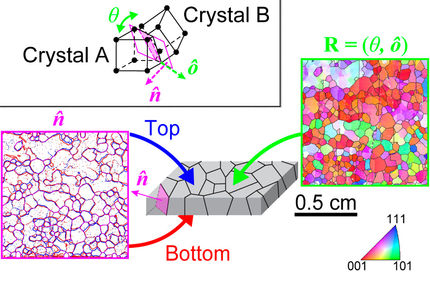ORNL microscopy inspires flexoelectric theory behind 'material on the brink'
electron microscopy, conducted as part of the Shared Research Equipment (ShaRE) User Program at the Department of Energy's Oak Ridge National Laboratory, has led to a new theory to explain intriguing properties in a material with potential applications in capacitors and actuators.
A research team led by ORNL's Albina Borisevich examined thin films of bismuth samarium ferrite, known as BSFO, which exhibits unusual physical properties near its transition from one phase to another. BSFO holds potential as a lead-free substitute for lead zirconium titanate (PZT), a similar material currently used in dozens of technologies from sensors to ultrasound machines.
Materials such as BSFO and PZT are often called "materials on the brink" in reference to their enigmatic behavior, which is closely tied to the transition between two different phases. These phases are characterized by structural changes in the material that produce different electrical properties.
"The best properties of the material are found at this transition," Borisevich said. "However, there has been a lot of discussion about what exactly happens that leads to an enhancement of the material's properties."
Using scanning transmission electron microscopy, the team mapped the position of atoms in BSFO films to find what happens to the local structure at the transition between ferroelectric and antiferroelectric phases. The team's results are published in Nature Communications.
"We discovered that neither of the two dominant theories could describe the observed behavior at the atomic scale," Borisevich said.
Some theorists have proposed that the material forms a nanocomposite at the transition. In this case, the energy of the boundaries between phases would have to approach zero, but Borisevich's team found experimentally something entirely different: the boundary's energy was instead effectively negative.
"When the energy of boundary is negative, it means that the system wants to have as many boundaries as possible, but with atom sizes being finite, you can't increase it to infinity," Borisevich said. "So you have to stop at some short-period modulated structure, which is what happens here."
Based on its observations, the team concluded that the mechanism behind the observed behavior was linked to a relatively weak interaction called flexoelectricity.
"Flexoelectricity means that you bend a material and it polarizes," said ORNL coauthor Sergei Kalinin. "It's a property present in most ferroelectrics. The effect itself is not necessarily very strong on macroscopic scales, but with the right conditions, which are realized in nanoscale systems, it can produce very interesting consequences."
Borisevich adds that the team's approach can be used to investigate a variety of systems with similar phase boundaries, and she emphasizes the importance of mapping out materials at the atomic scale.
"In this particular case, electron microscopy is the only way to look at very local changes because this material is a periodic structure," she said. "The decisive atomic-scale information had been missing from the discussion."
Most read news
Other news from the department science

Get the chemical industry in your inbox
By submitting this form you agree that LUMITOS AG will send you the newsletter(s) selected above by email. Your data will not be passed on to third parties. Your data will be stored and processed in accordance with our data protection regulations. LUMITOS may contact you by email for the purpose of advertising or market and opinion surveys. You can revoke your consent at any time without giving reasons to LUMITOS AG, Ernst-Augustin-Str. 2, 12489 Berlin, Germany or by e-mail at revoke@lumitos.com with effect for the future. In addition, each email contains a link to unsubscribe from the corresponding newsletter.






























































